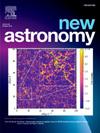Continuous O ’Connell effect and period variations of solar-like totally eclipsing contact binary BO Ari
IF 1.9
4区 物理与天体物理
Q2 ASTRONOMY & ASTROPHYSICS
引用次数: 0
Abstract
We obtained newly BV light curves for the contact binary BO Ari in 2023. The multi-color light curves were analyzed using the Wilson–Devinney (2013) program, which solutions reveal that BO Ari is a middle contact binary with q = 0.1778, f = 48% and a small temperature difference of 92 K. All minimum times were collected to re-calculated O-C. The O-C curves show a cyclic oscillation ( = 0.00337 d, = 16.35 yr) superimposed on a long-term decreasing (dP/dt = d ). This secular period decrease may be due to mass transfer from the more massive component to the less massive one. The cyclic trend was explained by the light-travel time effect due to the presence of a third body or magnetic activity. With this long-term mass transferring, the fill-out degree will increase. Furtherly, BO Ari will evolve into a deeply contact binary. In addition, during the monitoring of the space telescope Transiting Exoplanet Survey Satellite (TESS), it is the first time to discover continuous variation of the O’Connell effect in each cycle, obviously the positive O’Connell effect changes to a negative one over a short time. These phenomena imply the presence of possible magnetic activity on the surface of the component. Based on these fitting parameters, the hot spot and dark spot were found on the components.
连续的O ' Connell效应和周期变化的类日全蚀接触双星BO Ari
我们获得了2023年接触双星BO Ari的新的BVRcIc光曲线。利用Wilson-Devinney(2013)程序对多色光曲线进行分析,结果表明BO Ari为中接触双星,q = 0.1778, f = 48%,温差较小,为92 K。收集所有最小时间,重新计算O-C。O-C曲线表现为周期性振荡(A3 = 0.00337 d, T3 = 16.35 yr)叠加长期下降(dP/dt =−1.63×10−7 d yr−1)。这种长期周期的减少可能是由于质量从质量较大的组分转移到质量较小的组分。这种循环趋势可以用光传播时间效应来解释,这是由于第三个天体或磁活动的存在。随着这种长期传质,填充度会增大。此外,BO - Ari将演变成一个深度接触的双星。此外,在凌日系外行星巡天卫星(TESS)的监测过程中,首次发现了O 'Connell效应在每个周期内的连续变化,在短时间内明显由正的O 'Connell效应变为负的O 'Connell效应。这些现象暗示在组件表面可能存在磁活动。根据这些拟合参数,找出零件上的热点和暗斑。
本文章由计算机程序翻译,如有差异,请以英文原文为准。
求助全文
约1分钟内获得全文
求助全文
来源期刊

New Astronomy
地学天文-天文与天体物理
CiteScore
4.00
自引率
10.00%
发文量
109
审稿时长
13.6 weeks
期刊介绍:
New Astronomy publishes articles in all fields of astronomy and astrophysics, with a particular focus on computational astronomy: mathematical and astronomy techniques and methodology, simulations, modelling and numerical results and computational techniques in instrumentation.
New Astronomy includes full length research articles and review articles. The journal covers solar, stellar, galactic and extragalactic astronomy and astrophysics. It reports on original research in all wavelength bands, ranging from radio to gamma-ray.
 求助内容:
求助内容: 应助结果提醒方式:
应助结果提醒方式:


